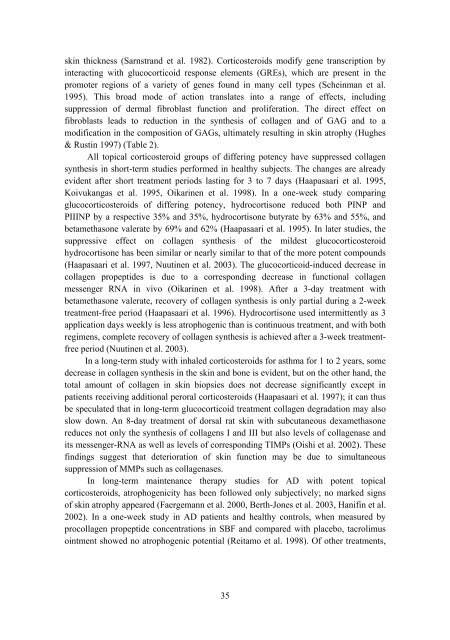Topical tacrolimus in atopic dermatitis: Effects of ... - Helda - Helsinki.fi
Topical tacrolimus in atopic dermatitis: Effects of ... - Helda - Helsinki.fi
Topical tacrolimus in atopic dermatitis: Effects of ... - Helda - Helsinki.fi
Create successful ePaper yourself
Turn your PDF publications into a flip-book with our unique Google optimized e-Paper software.
sk<strong>in</strong> thickness (Sarnstrand et al. 1982). Corticosteroids modify gene transcription by<br />
<strong>in</strong>teract<strong>in</strong>g with glucocorticoid response elements (GREs), which are present <strong>in</strong> the<br />
promoter regions <strong>of</strong> a variety <strong>of</strong> genes found <strong>in</strong> many cell types (Sche<strong>in</strong>man et al.<br />
1995). This broad mode <strong>of</strong> action translates <strong>in</strong>to a range <strong>of</strong> effects, <strong>in</strong>clud<strong>in</strong>g<br />
suppression <strong>of</strong> dermal <strong>fi</strong>broblast function and proliferation. The direct effect on<br />
<strong>fi</strong>broblasts leads to reduction <strong>in</strong> the synthesis <strong>of</strong> collagen and <strong>of</strong> GAG and to a<br />
modi<strong>fi</strong>cation <strong>in</strong> the composition <strong>of</strong> GAGs, ultimately result<strong>in</strong>g <strong>in</strong> sk<strong>in</strong> atrophy (Hughes<br />
& Rust<strong>in</strong> 1997) (Table 2).<br />
All topical corticosteroid groups <strong>of</strong> differ<strong>in</strong>g potency have suppressed collagen<br />
synthesis <strong>in</strong> short-term studies performed <strong>in</strong> healthy subjects. The changes are already<br />
evident after short treatment periods last<strong>in</strong>g for 3 to 7 days (Haapasaari et al. 1995,<br />
Koivukangas et al. 1995, Oikar<strong>in</strong>en et al. 1998). In a one-week study compar<strong>in</strong>g<br />
glucocorticosteroids <strong>of</strong> differ<strong>in</strong>g potency, hydrocortisone reduced both PINP and<br />
PIIINP by a respective 35% and 35%, hydrocortisone butyrate by 63% and 55%, and<br />
betamethasone valerate by 69% and 62% (Haapasaari et al. 1995). In later studies, the<br />
suppressive effect on collagen synthesis <strong>of</strong> the mildest glucocorticosteroid<br />
hydrocortisone has been similar or nearly similar to that <strong>of</strong> the more potent compounds<br />
(Haapasaari et al. 1997, Nuut<strong>in</strong>en et al. 2003). The glucocorticoid-<strong>in</strong>duced decrease <strong>in</strong><br />
collagen propeptides is due to a correspond<strong>in</strong>g decrease <strong>in</strong> functional collagen<br />
messenger RNA <strong>in</strong> vivo (Oikar<strong>in</strong>en et al. 1998). After a 3-day treatment with<br />
betamethasone valerate, recovery <strong>of</strong> collagen synthesis is only partial dur<strong>in</strong>g a 2-week<br />
treatment-free period (Haapasaari et al. 1996). Hydrocortisone used <strong>in</strong>termittently as 3<br />
application days weekly is less atrophogenic than is cont<strong>in</strong>uous treatment, and with both<br />
regimens, complete recovery <strong>of</strong> collagen synthesis is achieved after a 3-week treatment-<br />
free period (Nuut<strong>in</strong>en et al. 2003).<br />
In a long-term study with <strong>in</strong>haled corticosteroids for asthma for 1 to 2 years, some<br />
decrease <strong>in</strong> collagen synthesis <strong>in</strong> the sk<strong>in</strong> and bone is evident, but on the other hand, the<br />
total amount <strong>of</strong> collagen <strong>in</strong> sk<strong>in</strong> biopsies does not decrease signi<strong>fi</strong>cantly except <strong>in</strong><br />
patients receiv<strong>in</strong>g additional peroral corticosteroids (Haapasaari et al. 1997); it can thus<br />
be speculated that <strong>in</strong> long-term glucocorticoid treatment collagen degradation may also<br />
slow down. An 8-day treatment <strong>of</strong> dorsal rat sk<strong>in</strong> with subcutaneous dexamethasone<br />
reduces not only the synthesis <strong>of</strong> collagens I and III but also levels <strong>of</strong> collagenase and<br />
its messenger-RNA as well as levels <strong>of</strong> correspond<strong>in</strong>g TIMPs (Oishi et al. 2002). These<br />
f<strong>in</strong>d<strong>in</strong>gs suggest that deterioration <strong>of</strong> sk<strong>in</strong> function may be due to simultaneous<br />
suppression <strong>of</strong> MMPs such as collagenases.<br />
In long-term ma<strong>in</strong>tenance therapy studies for AD with potent topical<br />
corticosteroids, atrophogenicity has been followed only subjectively; no marked signs<br />
<strong>of</strong> sk<strong>in</strong> atrophy appeared (Faergemann et al. 2000, Berth-Jones et al. 2003, Hanif<strong>in</strong> et al.<br />
2002). In a one-week study <strong>in</strong> AD patients and healthy controls, when measured by<br />
procollagen propeptide concentrations <strong>in</strong> SBF and compared with placebo, <strong>tacrolimus</strong><br />
o<strong>in</strong>tment showed no atrophogenic potential (Reitamo et al. 1998). Of other treatments,<br />
35

















